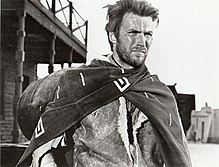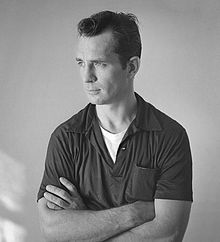Antihero

Anantihero(sometimes spelled asanti-hero)[1]oranti-heroineis a main character in a narrative (in literature, film, TV, etc.) who may lack some conventional heroic qualities and attributes, such asidealism,courage,andmorality.[1]Although antiheroes may sometimes perform actions that most of the audience considers morally correct, their reasons for doing so may not align with the audience's morality.[2]
Antihero is a literary term that can be understood as standing in opposition to the traditional hero, i.e., one with high social status, well liked by the general populace. Past the surface, scholars have additional requirements for the antihero. Some scholars[who?]refer to the "Racinian"antihero, who is defined by several factors. The first is that the antihero is doomed to fail before their adventure begins. The second constitutes the blame of that failure on everyone but themselves. Thirdly, they offer a critique of social morals and reality.[3]To other scholars, an antihero is inherently a hero from a specific point of view, and a villain from another.[4]This idea is further backed by the addition ofcharacter alignments,which are commonly displayed by role-playing games.[5]
Typically, an antihero is the focal point of conflict in a story, whether as the protagonist or as the antagonistic force.[6]This is due to the antihero's engagement in the conflict, typically of their own will, rather than a specific calling to serve the greater good. As such, the antihero focuses on their personal motives first and foremost, with everything else secondary.[7]
History[edit]

An early antihero isHomer'sThersites.[8]The concept has also been identified in classicalGreek drama,[9]Roman satire,andRenaissance literature[8]such asDon Quixote[9][10]and thepicaresquerogue.[11]
The term antihero was first used as early as 1714,[12]emerging in works such asRameau's Nephewin the 18th century,[8]and is also used more broadly to coverByronic heroesas well, created by theEnglishpoetLord Byron.[13]
LiteraryRomanticismin the 19th century helped popularize new forms of the antihero,[14][15]such as theGothic double.[16]The antihero eventually became an established form of social criticism, a phenomenon often associated with the unnamed protagonist inFyodor Dostoyevsky'sNotes from Underground.[8]The antihero emerged as afoilto the traditional heroarchetype,a process thatNorthrop Fryecalled the fictional "center of gravity".[17]This movement indicated a literary change in heroic ethos from feudal aristocrat to urban democrat, as was the shift from epic to ironic narratives.[17]
Huckleberry Finn(1884) has been called "the first antihero in the American nursery".[18]Charlotte Mullen ofSomerville and Ross'sThe Real Charlotte(1894) has been described as an anti-heroine.[19][20][21]
The antihero became prominent in early 20th centuryexistentialistworks such asFranz Kafka'sThe Metamorphosis(1915),[22]Jean-Paul Sartre'sNausea(1938),[23]andAlbert Camus'sThe Stranger(1942).[24]The protagonist in these works is an indecisive central character who drifts through his life and is marked byboredom,angst,andalienation.[25]
The antihero entered American literature in the 1950s and up to the mid-1960s as an alienated figure, unable to communicate.[26]The American antihero of the 1950s and 1960s was typically more proactive than his French counterpart.[27]The British version of the antihero emerged in the works of the "angry young men"of the 1950s.[9][28]The collective protests ofSixties counterculturesaw the solitary antihero gradually eclipsed from fictional prominence,[27]though not without subsequent revivals in literary and cinematic form.[26]
During theGolden Age of Televisionfrom the 2000s and into the present time, antiheroes such asTony Soprano,Jack Bauer,Gregory House,Walter White,Don Draper,Marty Byrde,Nucky ThompsonandJax Tellerbecame prominent in the most popular and critically acclaimed TV shows.[29][30][31]
See also[edit]
References[edit]
- ^ab"Anti-Hero".Lexico.Oxford University Press.Archived fromthe originalon 6 August 2020.Retrieved26 September2020.
- ^Laham, Nicholas (2009).Currents of Comedy on the American Screen: How Film and Television Deliver Different Laughs for Changing Times.Jefferson, North Carolina:McFarland & Co.p. 51.ISBN9780786442645.
- ^Kennedy, Theresa Varney (2014)."'No Exit' in Racine's Phèdre: The Making of the Anti-Hero ".The French Review.88(1): 165–178.doi:10.1353/tfr.2014.0114.ISSN2329-7131.S2CID256361158.
- ^Klapp, Orrin E. (September 1948)."The Creation of Popular Heroes".American Journal of Sociology.54(2): 135–141.doi:10.1086/220292.ISSN0002-9602.S2CID143440315.
- ^Waskul, Dennis; Lust, Matt (August 2004)."Role-Playing and Playing Roles: The Person, Player, and Persona in Fantasy Role-Playing".Symbolic Interaction.27(3): 333–356.doi:10.1525/si.2004.27.3.333.ISSN0195-6086.
- ^Petersen, Michael Bang (2019)."An Age of Chaos?".RSA Journal.165(3 (5579)): 44–47.ISSN0958-0433.JSTOR26907483.
- ^Klapp, Orrin E. (1948)."The Creation of Popular Heroes".American Journal of Sociology.54(2): 135–141.doi:10.1086/220292.ISSN0002-9602.JSTOR2771362.S2CID143440315.
- ^abcdSteiner, George (2013).Tolstoy Or Dostoevsky: An Essay in the Old Criticism.New York: Open Road. pp. 197–207.ISBN9781480411913.
- ^abc"antihero".Encyclopædia Britannica.14 February 2013.Retrieved9 August2014.
- ^Wheeler, L. Lip."Literary Terms and Definitions A".Dr. Wheeler's Website.Carson-Newman University.Retrieved3 October2013.
- ^Halliwell, Martin (2007).American Culture in the 1950s.Edinburgh:Edinburgh University Press.p.60.ISBN9780748618859.
- ^"Antihero".Merriam-Webster Dictionary.31 August 2012.Retrieved3 October2013.
- ^Wheeler, L. Lip."Literary Terms and Definitions B".Dr. Wheeler's Website.Carson-Newman University.Retrieved6 September2014.
- ^Alsen, Eberhard (2014).The New Romanticism: A Collection of Critical Essays.Hoboken:Taylor & Francis.p. 72.ISBN9781317776000.Retrieved20 April2015– viaGoogle Books.
- ^Simmons, David (2008).The Anti-Hero in the American Novel: From Joseph Heller to Kurt Vonnegut(1st ed.). New York:Palgrave Macmillan.p. 5.ISBN9780230612525.Retrieved20 April2015– viaGoogle Books.
- ^Lutz, Deborah (2006).The Dangerous Lover: Gothic Villains, Byronism, and the Nineteenth-century Seduction Narrative.Columbus:Ohio State University Press.p. 82.ISBN9780814210345.Retrieved20 April2015– viaGoogle Books.
- ^abFrye, Northrop (2002).Anatomy of Criticism.London:Penguin.p. 34.ISBN9780141187099.
- ^Hearn, Michael Patrick (2001).The Annotated Huckleberry Finn: Adventures of Huckleberry Finn (Tom Sawyer's Comrade)(1st ed.). New York:W. W. Norton & Company.p. xvci.ISBN0393020398.
- ^Ehnenn, Jill R. (2008).Women's Literary Collaboration, Queerness, and Late-Victorian Culture.Ashgate Publishing.p. 159.ISBN9780754652946.Retrieved7 April2020– viaGoogle Books.
- ^Cooke, Rachel (27 February 2011)."The 10 best Neglected literary classics – in pictures".The Guardian.Retrieved7 April2020.
- ^Woodcock, George (1 April 1983).Twentieth Century Fiction.Macmillan Publishers Ltd.p. 628.ISBN9781349170661.Retrieved7 April2020– viaGoogle Books.
- ^Barnhart, Joe E. (2005).Dostoevsky's Polyphonic Talent.Lanham:University Press of America.p. 151.ISBN9780761830979.
- ^Asong, Linus T. (2012).Psychological Constructs and the Craft of African Fiction of Yesteryears: Six Studies.Mankon: Langaa Research & Publishing CIG. p. 76.ISBN9789956727667– viaGoogle Books.
- ^Gargett, Graham (2004).Heroism and Passion in Literature: Studies in Honour of Moya Longstaffe.Amsterdam: Rodopi. p. 198.ISBN9789042016927– viaGoogle Books.
- ^Brereton, Geoffrey (1968).A Short History of French Literature.Penguin Books.pp. 254–255.
- ^abHardt, Michael; Weeks, Kathi (2000).The Jameson Reader(Reprint ed.). Oxford, UK; Malden, Massachusetts:Blackwell.pp. 294–295.ISBN9780631202707.
- ^abEdelstein, Alan (1996).Everybody is Sitting on the Curb: How and why America's Heroes Disappeared.Westport, Connecticut: Praeger. pp. 1, 18.ISBN9780275953645.
- ^Ousby, Ian (1996).The Cambridge Paperback Guide to Literature in English.New York:Cambridge University Press.p.27.ISBN9780521436274.
- ^Reese, Hope (11 July 2013)."Why Is the Golden Age of TV So Dark?".The Atlantic.Retrieved31 October2021.
A new book explains the link between the rise of antihero protaganists and the unprecedented abundance of great TV (and what Dick Cheney has to do with it).
- ^Faithfull, E. (2021). How House brought the "savant anti-hero" into the mainstream and changed TV dramas. nine.au.https:// nine.au/entertainment/latest/house-savant-anti-hero-medical-drama-9now/0e030210-8bfe-424f-b687-f2e36e6f0694
- ^Pruner, A. (n.d.). Hear us out: Gregory House was TV's last great doctor.https://editorial.rottentomatoes /article/hear-us-out-gregory-house-was-tvs-last-great-doctor/
